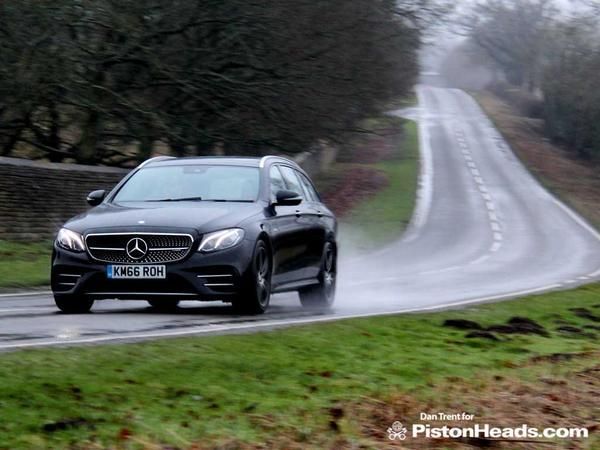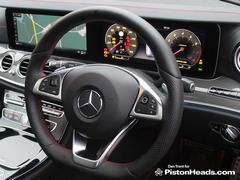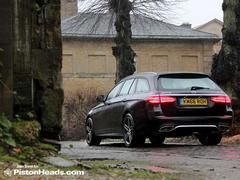Mercedes tyre 'skipping' - official statement
That unpleasant front axle hop on full lock in Mercedes-AMG '43 models? It's just a 'comfort issue' apparently...

So far we've driven estate versions of the C43 and E43 and liked both for their understated looks, strong performance, all-weather all-wheel drive and 'all you'd ever need' mix of practicality and pace. Both, however, have displayed an unpleasant sensation of the front tyres juddering in low speed manoeuvres while on full lock. It's a problem seemingly apparent on equivalent GLC models too, including the non '43 models. And one that's got more than a few PHers reporting in with their own experiences on their cars.
As promised we have been chasing for an official response and a statement has been forthcoming and is reproduced in full below. The official version is that it's nothing to do with the 4Matic all-wheel drive system, despite the sensation being very much like a 'tight' centre diff reacting to different rotational speeds on the front and rear axles when making tight turns. Mercedes says it's tyres struggling for grip in low ambient temperatures.
To be fair to Mercedes we've also felt similar characteristics on the Porsche Panamera 4S diesel we had in on test last week, also in the low temperatures Mercedes says contributes to the problem. It was nothing like as obvious as it was in the C- or E43 though. Nor does it seem to occur in our PH Fleet Audi S4, the car the C43 in particular seems aimed directly at and one that has a comparable performance remit and power output, if a different mechanical layout for its four-wheel drive system. It also has comparably sized 18-inch wheels to the C43, though Audi fits 245/45 tyres all round while Mercedes uses 245/40s on the rear and 225/50s on the front.
Whether owners will be entirely delighted at being told (we paraphrase...) 'they all do that sir, your dealer will be delighted to sell you another set of wheels with winter tyres fitted' is something we can leave to the thread that will inevitably follow this story. The response to being told it's "a comfort issue" would, having experienced it ourselves, quite reasonably be "too bloody right, that's why I'm not happy."
There is, of course, a more PH solution to this problem. Whether it's indeed the 4Matic system or the tyres you could instead put some of that budget allocated to the extra set of wheels and upgrade to an E63. Simply engage the RWD, ESP off, Drift Mode, let the rear tyres dictate your direction of travel and make your low-speed parking manoeuvres considerably more spectacular and smoky. Maybe AMG could introduce it on the '43 models and rebrand it 'Comfort Mode' and be done with it. Surely it's a 4Matic control unit reflash away from being made a reality... We'd take that over a set of winter tyres for sure.
Mercedes-Benz UK statement issued 24/1/17 and reproduced verbatim:
We're sorry to hear that a small number of customers have experienced an issue with certain models, generally at cold ambient temperatures while manoeuvring at low speed with steering lock applied. The experience is of the front tyres apparently 'skipping'. This is a comfort issue, and does not affect the safety or performance of the vehicle.
This characteristic comes from flexibility within the tyre sidewall, the grip between the front tyres and the type of road surface being driven over. It is something which can be felt only at very low speeds, and when a certain percentage of wheel lock is engaged for turning. This is demonstratively more evident in colder temperatures due to the changes in the tyre rubber elasticity.
Winter tyres and all-season tyres on 18- or 19-inch wheels improve this characteristic and we would always recommend their use in temperatures which fall below approximately +7 degrees Celsius. The use of 18-inch wheels with summer tyres also improves the issue.
We do, however, appreciate that is not always possible or practical for customers to fit alternative tyres or wheels, and our technical experts in the UK are investigating alternative ways to help minimise this characteristic.
Whether or not this is acceptable is down to the individual

I think one could argue it's just another disadvantage of the current fashion for enormous wheels and rubber-band type tyres.


Some cars do, however, exhibit this phenomenon. As I say, whether or not it's acceptable is an individual's opinion, but you can rest assured that with all considerations, and with everything Mercedes needed to achieve with this vehicle and combination of tyres, performance etc. that it was a necessary compromise. Most people think they can do everything better than everyone else, but that doesn't make it so

This is a way more complex subject than most people would at first think. Remember also that each wheel has to turn through a differing max lock left-to-right than the other wheel. There will be any number of considerations including, but not limited to, hub carriers, brake calipers, suspension struts, engine ancillary components and wheel arch liners. Retsrictions will often differ from one side of the car to the other, and most likely also between LHD or RHD. Big wheels and huge brakes will exasperate potential areas of concern on the performance variants.
I could go on, but it's pointless, as I didn't design the car. My only point is that there will be very good, and very considered reasons why this happens, and I am absolutely certain that no one here could have designed it any better. This is not a mistake, or a reliability issue.

"No one could have designed it any better"? What about all those other mfrs of cars which don't exhibit such behaviour?
I'm quite happy to accept that this is a consequence of incomplete-Ackermann geometry and ultra-low / ultra-stiff sidewalls. But does it REALLY need to be there?
I've seen a number of (rather clever) suspension geometry innovations, from Honda's 'compliance pivot' which removes longitudinal deflection on hitting potholes/other road deformations, mechanical and electrical 4-wheel steer systems to artificially change the effective wheelbase, king-pin-inclination compensators, 'RevoKnuckle'/'PerfoHub' and other torque-steer reducing systems...and probably others I've forgotten about.
So I'm sure those ever-so-clever bods at Mercedes COULD do it better, most probably if they had the budget...which Merc clearly chose to spend elsewhere...

In the interests of extreme-performance behaviour (>>100mph stability, which your average owner will experience...ooh, possibly NEVER!), and in the interests of "marketing/image" (ultra-low profile alloys on a heavy 4wd car, which make no f
 king sense whatsoever), Merc (and others it appears) have compromised day-to-day behaviour and tyre life?
king sense whatsoever), Merc (and others it appears) have compromised day-to-day behaviour and tyre life?Have I got that right? I just want to check that these oh-so-f
 king clever engineers have got their priorities straight...
king clever engineers have got their priorities straight... 
Lunatics / asylum...

Anyway, I'm not worrying that much - not in the market for a 4wd Merc - just stunned that the automotive industry can try and defend this s
 t...
t...For what it matters, I've owned a car (FWD) that exhibited this behaviour in cold temperatures on block paving. It wasn't very pleasant, but it also wasn't worth crying over. That said, I do of course freely admit to not having driven the Mercedes in question, but from the videos I've seen, it's no more severe than with any other car that also does it.
Well more fool you. I rather be classed a non technical person who doesn't know what he is talking about in a perfectly smooth car, than a fool who thinks it is normal to experience this. Truly quite remarkable how some convince themselves that a violently shaking vehicle is normal.
In the end, it is normal for compromises of this nature to occur when developing a car. You don't have to agree, but that won't stop it being true. Obviously any resulting effects will vary with application and condition. It would seem that Mercedes compromised a little too much in this instance, but it will be within the scope of what was deemed acceptable. That is to say that I highly doubt there is a simple and cost efficient engineering solution coming soon. But you never know of course!

The tyres skip on hard lock at slow speed. What's the positive outcome as a result of this compromise? I am guessing there isn't one
In reality it's just a poor design

Your assertion that it's poor design is an opinion, and of course one that you're entitled to, but it doesn't change any facts. This is not an unforeseen mistake. It's a compromise. Compromises never please everyone all the time

Gassing Station | General Gassing | Top of Page | What's New | My Stuff






